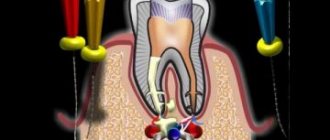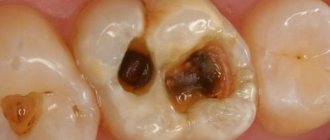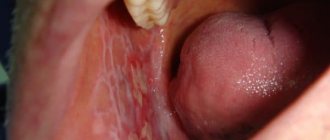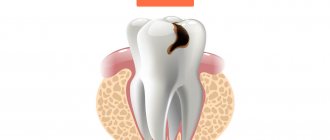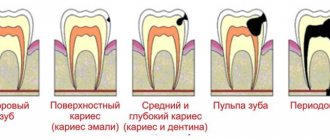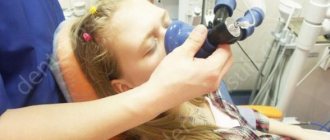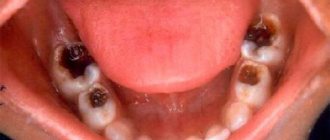Clinical picture
In acute focal pulpitis, inflammation is usually localized in the area of projection of the pulp horn and does not involve the entire coronal part. The duration of this stage is up to two days.
Complaints about:
• Acute spontaneous pain;
• Paroxysmal nature of pain (short attack of 10-20 minutes, long intermissions - several hours);
• Pain worsens at night;
• Pain intensifies from temperature stimuli (usually from cold), does not go away for a long time after the stimulus is removed;
• The patient correctly identifies the tooth that is bothering him (i.e., there is no irradiation of pain).
Anamnesis
Previously, short-term pain from all types of irritants was noted, there were no spontaneous pains, acute pain first appeared within 1-2 days.
Objectively:
During probing it is determined:
• Deep carious cavity that does not communicate with the tooth cavity;
• Large amount of softened dentin;
• Sharply painful at one point corresponding to the pulp horn.
Percussion is painless.
Palpation is painless.
Thermal diagnostics are painful and do not go away for a long time after the irritant is eliminated. It is characteristic that in case of acute focal pulpitis, water with a temperature of 28-30*C is a fairly strong irritant.
EDI 18-25 µA
Radiography reveals a deep carious cavity that does not communicate with the tooth cavity; there are no changes in the periapical tissues.
Symptoms
Symptoms of the disease are divided into general signs and factors that characterize this particular form of pathology.
Signs that indicate the presence of an acute form of pulpitis:
- Severe pain from exposure to irritants. The pain is especially worse in the evening and at night.
- The pain is pulsating. It may gradually subside, and then resume with renewed vigor.
Specific symptoms of acute diffuse pulpitis:
- Prolonged severe pain.
- The pain intensifies when the person is in a horizontal position.
- The pain may subside for just a few minutes, or a maximum of half an hour.
- Body temperature rises.
- The gums swell and bleed.
- The pain intensifies when pressing on the tooth.
- The pain may radiate to the ear or temple.
The subsidence of pain without treatment can only indicate that acute pulpitis is moving into the chronic stage.
We invite you to familiarize yourself with what a dental nerve looks like and how to kill it at home, a detailed illustration of the process and advice from dentists
Treatment
When treating acute diffuse pulpitis, dentists use several main types of treatment. Experts consider the following methods to be the most effective:
| Therapy methods | The main point |
| Conservative | The main purpose is to relieve symptoms and stop the focus of bacterial-toxic inflammation. For these purposes, medications are taken and physiotherapeutic procedures are carried out: depophoresis, UHF, laser treatment. |
| Dental | Depending on the pathogenesis of the disease, the following can be used:
|
| Surgical | It consists of partial or complete removal of purulent tissue. It is carried out using the following surgical techniques:
|
The note! The choice of a specific type of therapy is made exclusively by the dentist, taking into account the clinical picture of the disease and the general health of the patient.
Causes
The main cause of the disease is the action of microbes and the toxins they produce. The pathology usually begins with caries - the destruction of hard dental tissues with the formation of cavities. Then the microbes begin to penetrate deeply into the tissues and infect them. When the infection reaches the pulp through the dentinal tubes, pulpitis will develop. The process proceeds quite quickly, since microbes are easily spread by blood and lymph. That is why it is important to treat caries in a timely manner and always with the use of therapeutic pads.
Pulpitis can provoke injuries - chemical, physical, mechanical.
There are three stages of development of pulpitis - functional, structural and inflammatory. The speed of the process can be very different and depends on age, heredity, history of chronic and acute diseases, quality of nutrition, condition of periodontal tissues, and chewing loads.
Differential diagnosis
Different forms of the disease are characterized by different features of the course. When examining a patient and making a diagnosis, the dentist pays attention to the similarities and differences between different forms of pulpitis. This helps the doctor determine what kind of disease he is dealing with.
How to distinguish the acute form of the disease from the chronic?
An acute form of pulpitis occurs in a closed cavity of the tooth, pain accumulates in the pulp area and painful sensations spread not only to the tooth, but also to the jaw, head, and the general condition of the body as a whole worsens.
In the acute form of the disease, a person experiences aching pain. Any impact causes him additional suffering. Pain may spread along the trigeminal nerve. A tooth with a closed cavity is more susceptible to developing an acute form of the disease. A feature of the chronic form of the disease is the absence of pain that appears on its own. For pain to appear, external influence is required. The pulp chamber in this case is usually open and visible in the tooth cavity.
How does chronic pulpitis manifest?
- During an exacerbation, the symptoms of chronic pulpitis become identical to the symptoms of the acute form.
- The pain tends to subside for a while and then reappear. The intervals of lull are different for each patient.
- Painful sensations appear involuntarily, and under the influence of irritating factors intensify even more.
- A person does not always understand which tooth hurts.
- The pain spreads along the branches of the facial nerve.
What is acute focal pulpitis?
The main symptom of focal pulpitis is the localization of the pathological process in the area of projection of the pulp horn, without spreading to the entire coronal region. This stage usually lasts about two days.
How does acute focal pulpitis manifest?
Acute focal pulpitis - the initial stage of pulp inflammation begins in the area of the pulp horn, then spreads to the entire coronal part, and then the root pulp. The duration of this stage is no more than 2 days.
With this type of disease, the pain has a clear localization and is paroxysmal in nature. The attacks last about 20 minutes with breaks of several hours. Patients experience pain from any impact on the tooth. Most often it is caused by cold food, drinks and even air. Also, pain may appear in the evenings for no apparent reason. During the examination, the doctor reveals a carious cavity of impressive size. Probing it causes pain in the patient. Usually the cavity is closed, unless the dentist himself accidentally opened it during the drilling process. Percussion is accompanied by pain. The cold causes sharp pain, which does not immediately subside. In the focal form of pulpitis, the tooth begins to ache even when it gets exposed to water at a temperature of 30 °C. Electrodiagnostics shows the sensitivity of the pulp when exposed to a current of 18–20 μA. When diagnosing acute focal pulpitis, it is necessary to distinguish it from deep caries, acute diffuse and chronic fibrous pulpitis, since different types of disease require different treatment. Therefore, before starting treatment, the dentist must carefully examine the diseased tooth to determine which form of pulpitis it is affected by.
Cost of treatment
The price for dental services for a therapeutic complex for acute diffuse pulpitis depends on the degree of development of the pathology, the complexity of the dental procedures performed, as well as the level of the clinic.
In Moscow, the average cost of therapy for acute forms of diffuse pulpitis is:
- Single-rooted tooth – from 7500 rubles .
- Double-rooted tooth – from 9200 rubles .
- Three-rooted tooth – from 12,000 rubles .
The total cost of treatment includes: the doctor’s work, anesthetic drugs, materials used, hardware examination.
If you experience the slightest symptoms of acute diffuse pulpitis, you should immediately visit a dental clinic. Timely, qualified assistance will allow you to cure the disease in the early stages and prevent the development of serious consequences.
Acute pulpitis
| Diagnostic tests | D i a g n o z | |
| Pulp hyperemia | Acute limited pulpitis | |
| Anamnesis: interviewing the patient, clarifying complaints, characteristics of signs of the disease | Acute, spontaneous pain lasting 1-2 minutes in the area of the affected tooth, light intervals - 6-24 hours. Attacks intensify at night. Pain occurs from all irritants and lasts 1-2 minutes after their elimination. There is no irradiation of pain | Acute, spontaneous pain lasting 3-10 minutes, light intervals - from 2 hours or more. The attacks are worse at night. Pain occurs from all types of irritants and slowly calms down after they are eliminated. Occasionally radiates to adjacent teeth |
| The nature and depth of the carious cavity, characteristics of its contents | A cavity within the mantle or peripulpal dentin. The amount of softened dentin is associated with the nature of the development of caries and its localization | Deep carious cavity with a large amount of softened dentin, both mantle and peripulpal |
| Probing a carious cavity | Painful in a limited area of the bottom of the carious cavity, the pain persists even after stopping probing (not for long) | Painful in one point, pain persists after stopping probing |
| Vertical percussion of the tooth | Painless | Painless |
| Temperature test | Pain from cold water, which persists for 1-2 minutes after the irritant is removed | Painful reaction from cold or hot water that persists after the irritant has been removed |
| Electrical excitability (from the bottom of the carious cavity) | 8-12 µA | 15-25 µA |
TABLE 1 (CONTINUED)
| Acute* diffuse pulpitis | Acute purulent pulpitis | Traumatic pulpitis. |
| Acute, spontaneous, paroxysmal pain lasting 2 hours or more, light intervals - 10-30 minutes. Irradiation of pain along the branches of the trigeminal nerve, intensifies at night, in a horizontal position. Pain occurs from all types of irritants and persists for a long time after their elimination. | Spontaneous, tearing, throbbing pain, constant, subsides over a few minutes. Irradiation along the branches of the trigeminal nerve. The pain is worse at night. The pain is also intensified by a hot irritant, calmed by a cold one, any other irritants cause sharp pain | When the pulp is injured, there is short-term acute pain. When a tooth crown is fractured, there is acute pain radiating along the branches of the trigeminal nerve. Pain from all irritants, even from air movement |
| Deep carious cavity with a large amount of softened peripulpar dentin | The deep carious cavity is filled with a large amount of softened light dentin in acute caries and pigmented dentin in chronic caries. | When the pulp is injured, a pinpoint pink pulp gapes, and a drop of mucous-bloody fluid comes out. When the crown of a tooth is fractured, the pulp is exposed over a significant extent and is red in color. |
| Painful along the entire bottom of the carious cavity, pain persists after stopping probing | Sharply painful along the entire bottom, the arch of the tooth cavity is easily perforated with the release of a drop of pus | Sharply painful even with superficial probing (touching) |
| Painful | Painful | May be painful when the pulp is exposed |
| A painful reaction from cold or hot water persists for a long time with irradiation along the trigeminal nerve | The painful reaction of the tooth is calmed by cold water for 3-5 minutes | Sharply painful reaction from cold or hot water |
| 20-35 µA | 40-50uA |
Table 2. Differential diagnosis of acute pulpitis and other diseases
| Clinical signs | Diagnosis | |||
| Acute pulpitis | Acute or aggravated periodontitis | Acute sinusitis | Trigeminal neuralgia | |
| Nature of pain | The pain is acute, spontaneous, paroxysmal, intensifies at night and radiates along the branches of the trigeminal nerve | Constant aching pain, intensifies with mechanical impact on the tooth (biting) | Constant aching and throbbing pain in the upper jaw, radiating along the branches of the trigeminal nerve | Paroxysmal pain, debilitating, occurs spontaneously and stops abruptly |
| Factors that provoke pain | Temperature irritants when entering a carious cavity. After eliminating their effect, the pain decreases and gradually disappears | Touching a tooth or biting on it causes pain | Possible pain when biting on teeth that are adjacent to the inflamed sinus, when tilting the head | Mechanical and temperature stimuli in the area of trigger zones |
| Objective clinical symptoms | Probing the bottom of a carious cavity is sharply painful. With acute purulent pulpitis, pain on percussion is possible | Carious cavity, bottom probing is painless, sharp pain on percussion, swelling and hyperemia of the mucous membrane in the area of the causative tooth | Feeling of nasal congestion, difficulty breathing through the corresponding half of the nose, mucous or purulent discharge from the nose | Vegetative manifestations in the form of facial hyperemia, lacrimation, increased salivation. Reflex contractions of the masticatory muscles |
| General condition of the patient | Possible headache, weakness, decreased performance, especially with purulent pulpitis | Possible headache, weakness, sleep and appetite disturbances, increased body temperature | Increased body temperature, general weakness, headache, which intensifies when coughing, sneezing, or tilting the head. Fast fatiguability | Doesn't change. During an attack, the patient freezes in a suffering position, is afraid to move, holds his breath or vice versa, breathes quickly, squeezes or stretches the painful area |
Often there is a need to differentiate pulpitis from pulp tumors complicated by chronic periodontitis. Unlike acute periodontitis, pulpitis causes paroxysmal pain. With periodontitis, the pain is constant, persistent, aching, aggravated by mechanical stress (biting). If there is an open area of the pulp, its decay, gangrenous odor, painless probing, and slate coloration of the tooth enamel are determined, especially in the area of the projection of the tooth cavity.
Often there is a need to differentiate pulpitis from trigeminal neuralgia (Table 2). Pulpitis is characterized by causative or spontaneous paroxysmal pain that subsequently radiates to areas of the jaw, and sometimes to the entire half of the face, where the tooth is located. Unlike pain with neuralgia, pain with pulpitis begins with lightning speed, but lasts longer, sometimes for hours. With neuralgia, it is trigger-like in nature and lasts 2-3 minutes. The essence of the significance of the trigger zones is that irritation of areas of the skin and mucous membrane causes an attack of neuralgia. Characteristically, there are no painful attacks of trigeminal neuralgia at night. With pulpitis, as is known, the pain intensifies at night, especially in a horizontal position.
The clinical picture of pulp inflammation can simulate sinusitis. Thus, neuralgic pain radiating to other teeth, the back of the head, as well as headaches can also occur with inflammation of the maxillary sinus.
Differential diagnostic signs characteristic of sinusitis may be low-grade fever, a feeling of heaviness in the maxillary sinus, pain when pressing on the facial wall of the upper jaw, localization of pain in this area, mucopurulent discharge from the nose, swelling and hyperemia of the mucous membrane of the lower nasal cavity. shells. Crucial in the differential diagnosis is an X-ray examination that reveals veiling or sharp darkening of the maxillary sinus on the corresponding side.
Possible complications
One of the possible complications is pulp necrosis
Often, when toothache, characteristic of acute diffuse pulpitis, occurs, many people take strong painkillers. But, it is worth understanding that this only relieves symptoms and does not provide any treatment.
At the same time, the disease only progresses, microorganisms spread rapidly, which significantly increases the likelihood of developing complications such as:
- Acute periodontitis.
- Pulp necrosis.
- Periapical abscess.
- Purulent sinusitis.
- Abscess of the meninges in the pharynx.
Timely and correct treatment of the acute form of diffuse pulpitis will avoid the development of complications.

